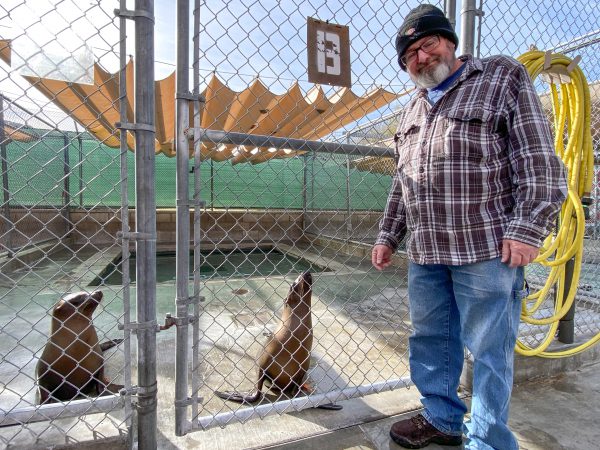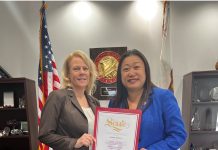Formerly homeless veteran finds new family at Marine Mammal Center
By Daniel Langhorne | LB Indy
Wayne Crawford enjoys watching California sea lions play in the rehabilitation pools at the Pacific Marine Mammal Center during his shifts as a custodian.
Not unlike the pinnipeds brought in sick or injured, the Army veteran was given a fresh start at the PMMC after living on the streets of coastal Orange County for more than four years.
“I was doing recycling to make money to eat,” he said.

Veteran Wayne Crawford likes to watch sea lions play in the rehabilitation pools at the Pacific Marine Mammal Center during his shifts as a custodian. Photo by Daniel Langhorne.
Life wasn’t always so dire for Crawford. The Riverside native worked at the data communications center in the White House’s basement for about six years during the Carter and Reagan administrations, according to records obtained under the Freedom of Information Act. After being discharged in 1985, Crawford went on to work for the U.S. Secret Service as a data network engineer for six years, he said.
Crawford’s extraordinary story illuminates a hard truth that homeless advocates have struggled to get the public to accept, which is people from all walks of life become homeless for a variety of reasons, not just drug abuse and mental illness.
“Many of Orange County’s current homeless veterans have extraordinary backgrounds and storied careers, and through no fault of their own have ended up on the street,” Becks Heyhoe, director of United to End Homelessness, wrote in a prepared statement. “There is a large misconception as to what causes homelessness in Orange County, but the reality is that leading factors include the inability to secure or retain a job with sustainable wages, rising housing costs, and family issues.”
The 2019 Point In Time count identified 311 veterans among the 6,860 homeless people in Orange County. Among this veteran population, 212 were unsheltered and 99 were in either emergency or transitional shelters.
Crawford was laid off in 2007 after a career in data networking with Sprint International and other telecommunications companies. He briefly moved to Atlanta, Georgia to live with his girlfriend but wasn’t successful in finding work there. He then returned to Riverside to live with his family. In 2010, he and his family members wanted more privacy, so he decided to move out.
Crawford said he rented a room for about a year, while he unsuccessfully searched for a job, using money he inherited from the sale of his mother’s house. He became homeless when the money ran out.
Attracted by coastal Orange County’s weather and natural beauty, Crawford lived for three years on the streets of Corona del Mar, where he received a mixed reaction from the locals.
“The residents are paying good money to live there and don’t want to see homeless people,” he said.
One Corona del Mar family invited Crawford to sleep on a cot at their home for a few months until they moved to a different place, he said. In September 2014, he was ticketed by Newport Beach police for unauthorized collection of recyclables, according to court records.
He credits his lengthy stretch in Corona del Mar to the fact he didn’t leave trash where he slept. A lot of the time nobody even noticed him, he said.
He then moved to Laguna Beach’s Heisler Park. After experiencing homelessness for more than four years, Crawford met Laguna Beach community outreach officer Jason Farris, who recommended he visit the Alternative Sleeping Location. Some nights it was easy to sleep there, some not.
“When I was there you had all kinds of people,” Crawford said. “You had people snoring, talking, and arguing with the staff.”
While at the ASL, he volunteered to launder fellow guests’ sheets, blankets, and towels. During the day, Crawford started visiting a picnic table at the Pacific Marine Mammal Center. That’s how he met former executive director Keith Matassa, who asked him to volunteer to clear a patch of dead brush south of the barn. Crawford agreed and filled three pick-up trucks with the trimmings over a number of weeks.
In December 2018, Friendship Shelter was able to find Wayne an apartment in permanent supportive housing in Rancho Santa Margarita. The Friendship Shelter provides him with a monthly bus pass so he can commute at no cost.
Last January, PMMC offered Crawford a job doing janitorial work and maintenance five days a week.
“I guess they were pleasantly surprised that I stuck it out,” he said.
Crawford’s duties include plumbing, landscaping, cleaning, laundry during the busy season, and picking up trash off Laguna Canyon Road at least twice a week. He also installs the Pathways for Pinnipeds bricks that are engraved with donors’ names and placed in the PMMC yard.
Michele Hunter, PMMC director of animal care, describes Crawford as a “godsend.”
“It’s a comfort knowing he’s around and always willing to lend a hand in many areas, from helping secure the facility in the pouring rain in times of imminent flooding, to simply keeping our areas clean,” Hunter said.
As a 60-year-old, Crawford said he plans to work at the PMMC as long as they’ll have him.
“Looking back, I’m just surprised I got the opportunity,” he said.
Friendship Shelter executive director Dawn Price wrote in an email that there are many extraordinary people experiencing homelessness, and the only way to know their stories is to get to know them.
“This story is a wonderful example of the magic that happens when we are willing to engage with people who are experiencing homelessness, and when we’re willing to learn what’s special about each individual,” Price wrote. “Both our team at Friendship Shelter and the staff at PMMC did that in this case, and all of us are better for having done so.”




